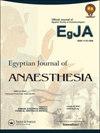The effect of low dose nalbuphine or ketamine in the prevention of emergence agitation after sevoflurane anesthesia in children undergoing tonsillectomy with or without adenoidectomy
IF 0.5
Q3 ANESTHESIOLOGY
引用次数: 0
Abstract
ABSTRACT Background Children’s agitation increases following sevoflurane anaesthesia. With indefinite results, nalbuphine and midazolam have been used as preventative treatments. Patients and Methods This study involved 90 children with American Society of Anesthesiologists score I-II and aged 4–10 who had sevoflurane-based adenotonsillectomy. Each child was randomly assigned to one of three groups; group N, group K, and group S. Nalbuphine was given to Group N at 0.1 mg/kg, ketamine was given to Group K at 0.25 mg/kg, and saline was given to Group S at equivalent volume. Sevoflurane was discontinued after the procedure, and the study drugs were given. The emergence agitation (EA) scale was used in the post-anesthesia care unit (PACU) to measure agitation upon admission (T0), after 5 min (T5), 10 min (T10), 15 min (T15), 20 min (T20), 25 min (T25), and 30 min (T30). Clinical trials. gov ID: NCT05176119. Results In the PACU, the incidence of EA was significantly lowered in N (6.6%) and K Group (16.6%) compared to S group (33%) with (p = 0.044), the duration in PACU was significantly prolonged in S in comparison to K and N groups (p-value = 0.011), more patients experienced postoperative pain in S group compared to N group and K group (p-value < 0.001). Conclusion Children who had sevoflurane-induced adenotonsillectomy can avoid emergence agitation with ketamine 0.25 mg/kg or nalbuphine 0.1 mg/kg.小剂量纳布啡或氯胺酮对预防接受扁桃体切除术合并或不合并腺样体切除术的儿童在七氟醚麻醉后出现躁动的影响
ABSTRACT 背景 七氟醚麻醉后,儿童的躁动会加剧。纳布啡和咪达唑仑被用作预防性治疗,但效果并不明显。患者和方法 本研究涉及 90 名美国麻醉医师协会评分为 I-II 级、年龄在 4-10 岁的儿童,他们都接受了基于七氟醚的腺扁桃体切除术。N 组给予 0.1 毫克/千克的纳布啡,K 组给予 0.25 毫克/千克的氯胺酮,S 组给予等量的生理盐水。手术结束后停止使用七氟醚,并给予研究药物。在麻醉后护理病房(PACU)使用出院躁动(EA)量表测量入院时(T0)、5分钟后(T5)、10分钟后(T10)、15分钟后(T15)、20分钟后(T20)、25分钟后(T25)和30分钟后(T30)的躁动情况。临床试验:NCT05176119。结果 在PACU中,与S组(33%)相比,N组(6.6%)和K组(16.6%)的EA发生率明显降低(p = 0.044);与K组和N组相比,S组的PACU持续时间明显延长(p值 = 0.011);与N组和K组相比,S组有更多患者出现术后疼痛(p值< 0.001)。结论 使用氯胺酮 0.25 毫克/千克或纳布啡 0.1 毫克/千克可避免接受七氟醚诱导的腺扁桃体切除术的儿童出现躁动。
本文章由计算机程序翻译,如有差异,请以英文原文为准。
求助全文
约1分钟内获得全文
求助全文
来源期刊

Egyptian Journal of Anaesthesia
Medicine-Anesthesiology and Pain Medicine
CiteScore
0.90
自引率
0.00%
发文量
78
 求助内容:
求助内容: 应助结果提醒方式:
应助结果提醒方式:


